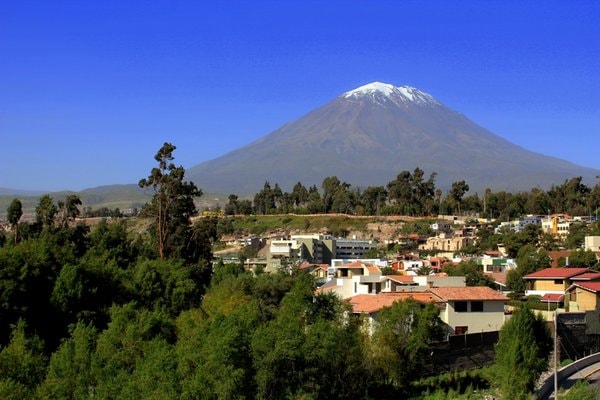The most famous of these is Misti, located near the Andean city of Arequipa, the second biggest city in Peru. The volcano, which is almost six thousand meters high, is classified as a stratovolcano, or a volcano that acquires the shape of a cone with time because of eruptions. Formerly, the volcano was almost completely covered in snow, turning into a postcard for the city of Arequipa. Currently, only a very small percentage of the volcano is covered by snow, due principally to global warming and the fact that it is located in a dry climate where there isn’t enough water to maintain the snow.
Misti is not considered to be a volcano of intense activity. However, those in Arequipa can see smoke expelling from the volcano. All of the region of Arequipa is fertile, thanks to the acidic ash that comes from Misti. During the 20th century, there have been at least five small eruptions, which demonstrates that the volcano does represent a threat to the city as Arequipa would be hit if it began to spew lava.
Before the arrival of the Spaniards, the area where Misti is located was occupied by various Andean people. In 1998, six human skeletons were found that, according to research, were from the Incan period. The researchers believe that the bodies were a part of a religious ceremony of human sacrifice, confirming that the volcano was sacred for the Incas. As with other Pre-Colombian cultures, the Incas also used to perform human sacrifices in worship of the Sun God. Currently, all of these mummies are exhibited in the Museo Santuário de Altura Sur Andino, owned by the Universidad Católica de Santa Maria, in Arequipa. At the same museum are other important mummies found in the Andes such as Juanita, the most famous, which was found on snowy Ampato in 1995.
The hike will be very tiring but it will be worth it. When you arrive at the top, you will see the crater, large and full of colors, with a lot of smoke and sulfur. Outside of this, the view is incredible because you will be surrounded by clouds and be able to see the city of Arequipa. Along the hike you will also see many animals and plants endemic to the region.
The descent, as normal, is much easier and faster than the ascent. To descend, it’s necessary to slide along a route full of stones and sand. You’ll need to be careful not to fall or twist your foot. It takes around two hours to arrive at 4 thousand meters where 4×4 trucks will normally be waiting for the group to return to Arequipa.
The architecture of Arequipa also calls the attention of its visitors. Almost all of the buildings in the historic center are made out of sillar, a rock made of material of volcanic origins. As sillar is whitish, Arequipa is called the White City.
Article courtesy of Intiways Travel, travel packages to Peru
If you want more information or want to hire a tour to the Misti volcano, you can contact Intiways from Peru using the following:
Email: Info@intiways.travel
Site: www.intiways.travel
Twitter: @Intiways
Facebook: facebook.com/Intiways
*Article was written by Lia Petrucelli, Manager of Operations at Intiways Travel, a tourist agency specialized in Inbound Luxury Tourism and tailor-made trips in Lima, Peru. Translated from the original into English by Nikki Elliott.

